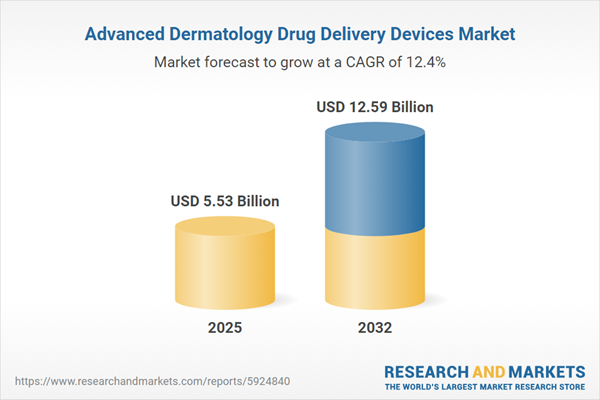Speak directly to the analyst to clarify any post sales queries you may have.
The advanced dermatology drug delivery devices market is expanding as stakeholders respond to new clinical requirements and technology advances that improve therapeutic efficacy and patient adherence. Senior decision-makers must understand the crucial developments and trends guiding this high-potential sector as they chart effective strategies for growth and investment.
Market Snapshot: Advanced Dermatology Drug Delivery Devices
The Advanced Dermatology Drug Delivery Devices Market grew from USD 4.92 billion in 2024 to USD 5.53 billion in 2025. It is projected to maintain a CAGR of 12.44%, reaching USD 12.59 billion by 2032. This robust expansion highlights rising demand for minimally invasive dermatology drug delivery systems and innovative approaches in topical and transdermal therapies. The market is benefiting from increased incidence of chronic skin conditions and significant progress in both traditional and digitally enabled treatment solutions.
Scope & Segmentation
This report offers a comprehensive analysis of market drivers, segmentation, and regional perspectives for senior decision-makers, providing an essential tool for planning and benchmarking strategies in the advanced dermatology drug delivery devices landscape.
- Technology: Electroporation, Iontophoresis, Jet Injector, Microneedles, Transdermal Patch
- Electroporation: High-Voltage, Low-Voltage
- Iontophoresis: Continuous, Pulsed
- Jet Injector: Gas-Powered, Spring-Loaded, Ultrasonic
- Microneedles: Coated, Dissolving, Hollow, Solid
- Transdermal Patch: Adhesive, Matrix, Reservoir
- Application: Cosmetic (Anti-Aging, Hair Regrowth, Scar Treatment, Skin Lightening), Therapeutic (Acne, Eczema, Pain Management, Psoriasis)
- End User: Dermatology Clinics (Cosmetic Centers, General Clinics), Home Healthcare, Hospitals (Private, Public), Research Laboratories (Academic, Pharma)
- Drug Type: Gene Therapy (mRNA, Plasmid DNA), Protein Peptide (Hormone, Monoclonal Antibody), Small Molecule, Vaccine
- Release Profile: Controlled Release (Pulsatile, Zero Order), Immediate Release, Sustained Release
- Regions: Americas (United States, Canada, Mexico, Brazil, Argentina, Chile, Colombia, Peru), Europe (United Kingdom, Germany, France, and others), Middle East (UAE, Saudi Arabia, Qatar, Turkey, Israel), Africa (South Africa, Nigeria, Egypt, Kenya), Asia-Pacific (China, India, Japan, Australia, South Korea, Indonesia, Thailand, Malaysia, Singapore, Taiwan)
- Covered Companies: 3M Company, Becton Dickinson and Company, Teva Pharmaceutical Industries Ltd., Galderma S.A., Novartis International AG, Johnson & Johnson, Pfizer Inc., Merck & Co., Inc., Sanofi S.A., Bayer AG
Key Takeaways for Senior Decision-Makers
- Emerging delivery device platforms such as microneedles, smart patches, iontophoresis, and jet injectors are transforming both cosmetic and therapeutic dermatology by providing improved precision and patient-compliant options.
- Advancements in materials science and digital integration now enable programmable drug release, real-time efficacy monitoring, and tailored patient dosing across a spectrum of skin conditions.
- Industry collaborations are crucial, bringing together manufacturers, pharmaceutical firms, and technology providers to streamline clinical validation and accelerate the deployment of combination drug-device products.
- Adoption patterns vary across regions due to differences in regulatory frameworks, infrastructure maturity, and health system incentivization—necessitating localized strategies for successful market entry and scaling.
- The trend toward value-based care and payer focus on total cost of ownership is shaping procurement practices, making outcome-driven device evaluation central to purchasing decisions.
- Patent activity focuses on sensor integration and closed-loop systems, reflecting the strategic shift to personalized, minimally invasive solutions and smart dermatology care.
Tariff Impact: Navigating New Challenges in 2025
Recent tariff changes affecting imported dermatology drug delivery device components have introduced complex supply chain challenges. These include increased landed costs and a shift toward near-shoring, prompting manufacturers to reevaluate supplier networks and focus on domestic R&D for high-precision components. Companies are also leveraging free trade zones and forming new alliances to maintain supply resilience and mitigate cost pressures, especially for essential microfabricated arrays and electronic components.
Methodology & Data Sources
This research applies a mixed-methods approach combining primary interviews with dermatology experts, engineers, and procurement leaders, and secondary research through peer-reviewed journals, regulatory policies, and patent analysis. Quantitative models assessed device use, adoption patterns, and performance metrics to assure data accuracy, while stringent editorial oversight and peer review protect reliability throughout the research process.
Why This Report Matters
- Provides actionable market intelligence to support investment, strategic partnerships, and innovation decisions in advanced dermatology drug delivery.
- Helps companies benchmark innovation pipelines and commercialization strategies against regional variances and evolving payer requirements.
- Equips senior leaders with evidence-based guidance to respond to tariff policies and identify the highest-impact growth opportunities.
Conclusion
This report delivers an essential overview of the advanced dermatology drug delivery devices market, highlighting transformative technologies, evolving regulatory landscapes, and new collaborative strategies for industry growth. Senior decision-makers can leverage these insights to drive competitive positioning and long-term value in the dermatology sector.
Additional Product Information:
- Purchase of this report includes 1 year online access with quarterly updates.
- This report can be updated on request. Please contact our Customer Experience team using the Ask a Question widget on our website.
Table of Contents
3. Executive Summary
4. Market Overview
7. Cumulative Impact of Artificial Intelligence 2025
Companies Mentioned
The companies profiled in this Advanced Dermatology Drug Delivery Devices market report include:- 3M Company
- Becton, Dickinson and Company
- Teva Pharmaceutical Industries Ltd.
- Galderma S.A.
- Novartis International AG
- Johnson & Johnson
- Pfizer Inc.
- Merck & Co., Inc.
- Sanofi S.A.
- Bayer AG
Table Information
| Report Attribute | Details |
|---|---|
| No. of Pages | 194 |
| Published | November 2025 |
| Forecast Period | 2025 - 2032 |
| Estimated Market Value ( USD | $ 5.53 Billion |
| Forecasted Market Value ( USD | $ 12.59 Billion |
| Compound Annual Growth Rate | 12.4% |
| Regions Covered | Global |
| No. of Companies Mentioned | 11 |









